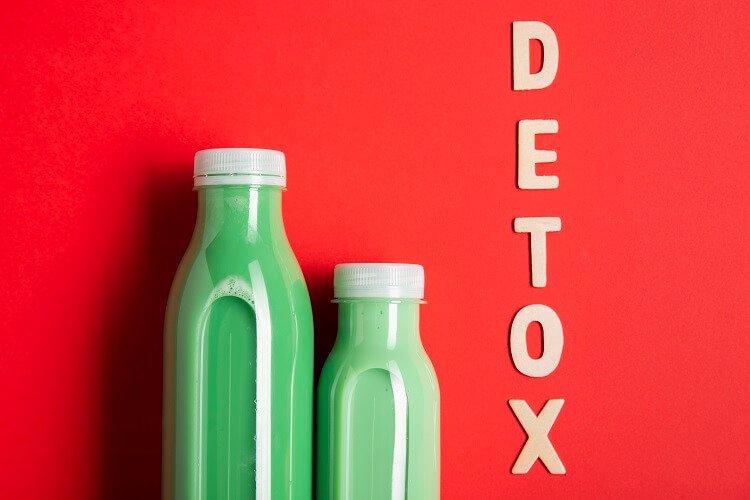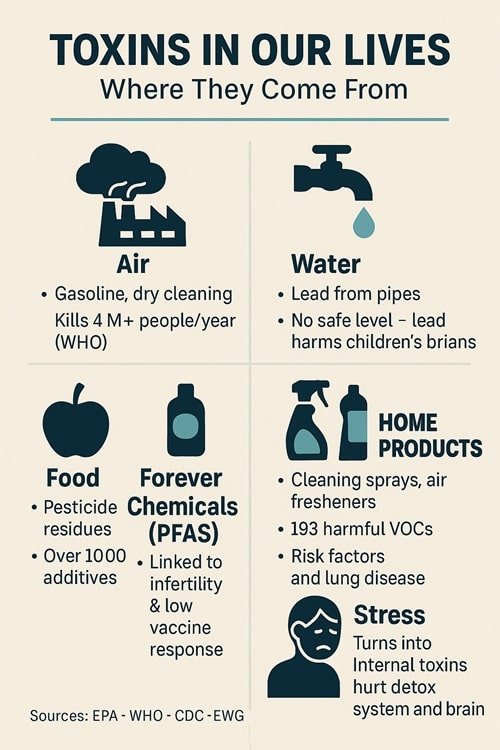How to Naturally Detox Your Body: Your Guide to a Cleaner, Energized You
Ditch the detox myths and empower your body's natural cleansing systems with these science-backed, actionable steps.

Your body is already a detox machine. While Instagram influencers push expensive cleanses and celebrities tout magical juice fasts, your liver, kidneys, and other organs are working 24/7 to eliminate toxins with remarkable efficiency.
Harvard Medical School confirms what science has known for decades – “The human body can defend itself very well against most environmental insults and the effects of occasional indulgence.”
Three things matter most:
- First, understand how your natural detox systems actually work.
- Second, recognize the real environmental challenges they face.
- Third, support them through evidence-based lifestyle choices rather than costly quick fixes.
The CDC’s National Report on Human Exposure to Environmental Chemicals documents measurable levels of 352 different chemicals in the U.S. population, from pesticides to household cleaners to industrial pollutants. [1]
Your body faces an unprecedented chemical burden, but the solution isn’t found in expensive supplements or restrictive cleanses – it’s in understanding and supporting the detoxification systems you already possess.
The Truth About “Detoxing”
Before wellness marketing hijacked the term, “detox” referred to a specific medical procedure for treating dangerous levels of alcohol, drugs, or poisons in hospital settings. [2]
Dr. Robert Shmerling from Harvard Medical School puts it bluntly:
“It’s hard for me to be enthusiastic about the use of detox diets or cleanses… Leave the detoxification to the professionals: your kidneys, liver, and other self-cleaning organs of your body.” [3]
Your body operates sophisticated detoxification systems continuously.
- The liver processes over 500 functions, filtering 1.5 liters of blood per minute through a two-phase detoxification system. [4]
- Phase I enzymes (cytochrome P450) break down fat-soluble toxins, while Phase II enzymes package them for elimination. [5]
- Your kidneys filter 200 quarts of blood daily, removing waste through urine. [6]
- The lymphatic system moves cellular waste and toxins through a network of vessels and nodes, while your lungs expel volatile chemicals with every breath. [7] [8]
Johns Hopkins hepatologist Dr. Tinsay Woreta explains:
“Your liver represents the human body’s primary filtration system, converting toxins into waste products, cleansing your blood, and metabolizing nutrients and medications.” [9]
This happens automatically, without expensive interventions.
The Mayo Clinic’s position is clear:
“There’s little evidence that dietary cleanses do any of the things they promise. The fact is you don’t need to purchase a product to cleanse your body. Your liver, kidneys and gastrointestinal tract do a good job of detoxing it every day.” [10]
Plus, a 2015 systematic review concluded there was no compelling research supporting commercial detox diets for toxin elimination or weight management. [11]
What We’re Actually “Detoxing” From?

Your detox systems face genuine challenges in today’s environment. Understanding what you’re up against helps you make smarter choices about supporting your natural defenses.
- Environmental toxins infiltrate through multiple pathways. The EPA (U.S. Environmental Protection Agency) lists 188 toxic air pollutants including benzene from gasoline, perchloroethylene from dry cleaning, and heavy metals like mercury and lead.
- Fine particulate matter from vehicle emissions and industrial processes causes over 100,000 premature deaths annually in the U.S. WHO estimates outdoor air pollution contributes to more than 4 million deaths yearly from stroke, heart disease, and lung cancer. [12]
- Water contamination adds another layer of exposure. Lead has no safe level according to the EPA and CDC, corroding from pipes and fixtures to cause neurological damage and learning disabilities in children.
- PFAS “forever chemicals” persist in drinking water and food packaging, linked to decreased fertility, increased blood pressure during pregnancy, and reduced vaccine response. [13]
- Your food carries chemical residues despite safety regulations. The EPA regulates over 350 pesticides on food, though the USDA’s Pesticide Data Program generally finds residues below health risk thresholds. Food additives present a bigger concern – the FDA oversees about 10,000 additives with limited testing requirements, and food companies aren’t required to report safety studies.
- Hidden household toxins may pose the biggest daily exposure. Environmental Working Group research found 530 unique volatile organic compounds (VOCs) emitted from 30 common cleaning products, with 193 classified as hazardous [14]. VOC concentrations indoors often run 2-10 times higher than outdoors [15]. Professional cleaners face 50% higher asthma risk and 43% higher COPD risk due to chemical exposure [16].
- Stress creates internal toxins through cortisol elevation and inflammatory responses. Chronic stress increases oxidative damage markers, depletes glutathione (your body’s master antioxidant), and impairs liver detoxification enzyme function [17]. When you’re chronically stressed, you’re literally more toxic at the cellular level.
The reality is that you’re constantly exposed to chemicals through air, water, food, household products, and stress responses. But rather than feeling overwhelmed, recognize that your detox systems evolved to handle environmental challenges – they just need proper support through lifestyle choices.
The 8 Pillars of Natural Detoxification
Pillar 1: Hydrate for Health

Water serves as your body’s transportation system for toxins. Proper hydration supports kidney function, helps maintain lymphatic flow, and allows cellular waste removal. Your kidneys filter waste products and excess substances from blood into urine, but they need adequate fluid to function optimally. [18]
How much do you actually need? The old “8 glasses a day” rule provides a reasonable starting point, but individual needs vary based on activity level, climate, and body size. Monitor your urine color – pale yellow indicates adequate hydration, while dark yellow suggests you need more fluids.
Herbal teas offer bonus benefits beyond hydration.
- Dandelion tea contains polyphenols and potassium that support liver function and act as a natural diuretic. A 2017 study showed dandelion polysaccharides beneficial for liver health. Drink 2-3 cups daily, with root preparations offering stronger liver support than leaf varieties. [19]
- Ginger tea provides anti-inflammatory compounds called gingerols that reduce oxidative stress and support digestive function. [20] These teas count toward your daily fluid intake while delivering targeted benefits for your natural detox systems.
TIPS: Start each morning with a large glass of water before coffee or tea. Keep a water bottle visible as a reminder throughout the day. If plain water feels boring, add lemon slices, cucumber, or mint for flavor without added sugars that burden your liver.
Pillar 2: Fuel with Detox-Supporting Foods

Your diet provides the raw materials your detox systems need to function. Instead of restricting calories through cleanses, focus on foods that actively support natural detoxification pathways.
- Dark chocolate (70-85% cacao) contains 2-3 times more polyphenols than green tea, with flavonoids like catechin and epicatechin that neutralize free radicals. Research shows 20-50 grams daily can improve mood and increase beneficial gut bacteria diversity. Choose high-quality dark chocolate and savor it slowly. [21]
- Berries pack antioxidant power through anthocyanins and polyphenols. Studies show flavonoid intake of about 500mg daily (equivalent to 2 cups of tea or a generous handful of berries) correlates with 16% lower risk of all-cause mortality. Mix blueberries, blackberries, raspberries, and strawberries for diverse compounds that work synergistically. [22]
- Fiber acts like a broom for your digestive system, binding toxins for elimination while feeding beneficial gut bacteria. Soluble fiber forms a gel-like substance that traps waste, while insoluble fiber speeds transit time through your intestines. Aim for 25-35 grams daily from varied sources: apples (3-4g), pears, carrots (2g per cup cooked), oats, quinoa (8g per cup), and legumes. [23]
- Cruciferous vegetables deserve special attention for liver support. Broccoli, Brussels sprouts, kale, and cauliflower contain glucosinolates – sulfur compounds that convert to bioactive isothiocyanates like sulforaphane. These compounds activate Phase II detoxification enzymes and support glucuronidation pathways critical for toxin elimination. [24]
According to Clinical trials 250 grams daily of Brussels sprouts and broccoli significantly increased Phase II enzyme activity [25]. A study of 1,005 women showed higher cruciferous intake correlated with lower inflammatory markers [26]. To maximize beneficial enzyme activity, chop cruciferous vegetables and let them sit 10 minutes before cooking, then steam lightly for 3-4 minutes. [27]
- Alliums (garlic and onions) provide organosulfur compounds that enhance detoxification through sulfation pathways [28]. Garlic’s allicin content (2.5-4.5mg per gram) supports glutathione synthesis – your body’s master antioxidant [29]. Research also shows garlic reduces lead toxicity by 19% in workers with heavy metal exposure. [30].
TIP: Include 1-2 garlic cloves or half an onion daily in cooking.
- Gut health directly impacts detoxification capacity. Beneficial bacteria alter toxin structure to prevent absorption and produce enzymes that neutralize harmful compounds. [31] Include fermented foods like yogurt, kefir, sauerkraut, and kimchi for probiotics, plus prebiotic foods like asparagus, bananas, and Jerusalem artichokes to feed beneficial bacteria.
Sample 1-Day Detox-Friendly Meal Plan:
- Breakfast: Steel-cut oats topped with mixed berries and chopped walnuts, green tea
- Lunch: Large salad with dark leafy greens, roasted broccoli, chickpeas, avocado, garlic vinaigrette
- Snack: Apple slices with almond butter, dandelion tea
- Dinner: Baked salmon with roasted Brussels sprouts and sweet potato, sauerkraut on the side
- Evening: Small square of dark chocolate (85% cacao), ginger tea
This approach provides approximately 30+ grams of fiber, multiple servings of cruciferous vegetables, fermented foods, and antioxidant-rich options while supporting all phases of natural detoxification.
Pillar 3: Limit the Liver Loaders

Your liver bears the heaviest detoxification burden, so reducing its workload allows better processing of unavoidable toxins. Alcohol metabolism generates reactive oxygen species Nih and depletes antioxidants while creating acetaldehyde, a toxic intermediate compound. [32] [33]
Chronic alcohol consumption downregulates detoxification enzymes and promotes liver inflammation. The progression from fatty liver to hepatitis to fibrosis happens gradually, but your liver has remarkable regenerative capacity when alcohol intake stops [34]. If you drink regularly, consider alcohol-free days or weeks to give your liver recovery time.
Processed foods create multiple challenges for detoxification. Advanced glycation end products (AGEs) formed during processing increase oxidative stress. Artificial preservatives, colors, and flavors require processing by detoxification enzymes. High sugar content contributes to fatty liver disease and impaired liver function. [35]
Rather than complete deprivation (which often backfires), focus on reduction strategies.
- Replace sugary drinks with herbal teas or water with lemon.
- Choose whole grain versions of refined products.
- Read ingredient lists and opt for foods with fewer additives.
- Cook more meals at home where you control ingredients.
When you do indulge, pair problematic foods with detox supporters.
- Have dark chocolate instead of milk chocolate.
- Choose red wine over cocktails if drinking alcohol (red wine contains resveratrol and other antioxidants).
- Add extra vegetables to pizza or pasta dishes.
Remember: your liver processes everything you consume, from nutrients to medications to toxins. Giving it fewer burdens allows better performance of necessary functions.
Pillar 4: Move Your Body, Move the Toxins

Unlike your cardiovascular system with its central pump (your heart), the lymphatic system relies entirely on muscle contractions and breathing to move lymph fluid throughout your body. [36] Exercise can increase lymph clearance rates by 3-6 fold compared to resting levels. [37]
Any movement helps, but certain activities provide particular benefits. Vertical movements like dancing, jumping, or rebounding can increase lymph flow by 15-30 times by opening and closing one-way lymphatic valves. Water-based exercise offers unique advantages due to water pressure enhancing lymphatic drainage. [37]
Diaphragmatic breathing serves as the single most effective exercise for central lymphatic stimulation via the thoracic duct. [38] [39]
Practice this daily: lie down with one hand on your chest, one on your belly. Breathe so only the bottom hand moves, expanding your diaphragm. Continue for 5-10 minutes.
The TOLF-HF study demonstrated that just 8 minutes of lymphatic exercises (muscle-tightening deep breathing, pumping movements, large muscle exercises) effectively reduced fluid overload symptoms in heart failure patients. You don’t need intense workouts – consistent movement matters more than intensity. [40]
Sweating provides some detox benefits, though research shows mixed results. Sauna use can increase excretion of certain heavy metals and carcinogenic compounds, though concentrations remain low. [41] [42]
The cardiovascular benefits of sauna use (40 studies involving 3,855 participants showed positive effects) Nih likely provide more detox support than direct toxin elimination through sweat. [43]
Try traditional saunas at 150-180°F for 15-20 minutes, 2-3 times weekly, or infrared saunas at 120-140°F for 20-40 minutes. Always hydrate properly before, during, and after sessions.
Find movement you actually enjoy – combat sports, dancing, hiking, swimming, yoga, strength training, or simply walking. Consistency trumps intensity for lymphatic support. Even 5 minutes of targeted lymphatic exercises daily provides measurable benefits.
Pillar 5: Prioritize Rest and Recovery

Sleep represents the most underappreciated detox practice. The glymphatic system, discovered in 2012, serves as your brain’s waste clearance network, and 80-90% of this critical cleaning happens during deep sleep phases. [44]
During sleep, your brain’s extracellular space expands by 60%, allowing cerebrospinal fluid to flush out metabolic waste including amyloid-beta and tau proteins associated with Alzheimer’s disease. Sleep deprivation reduces this waste clearance by up to 60%, essentially leaving toxic buildup in your brain. [45]
The research shows that sleep apnea patients have 70% higher Alzheimer’s risk due to impaired glymphatic function. [46]
A systematic review of 19,129 participants showed sleep problems correlate with increased concentrations of toxic proteins in cerebrospinal fluid. Your brain processes approximately 7 grams of damaged proteins daily through this system. [48] [49]
Sleep quality matters more than just duration. Peak liver detoxification occurs between 11 PM and 1 AM, emphasizing the importance of earlier bedtimes. Side sleeping may optimize glymphatic clearance compared to back or stomach positions.
Create a sleep environment that supports detoxification: consistent bedtime and wake time (including weekends), 7-9 hours nightly, cool temperature (60-67°F), complete darkness, and minimal blue light exposure 1-2 hours before bed. Get morning sunlight before 10 AM to regulate your circadian rhythm.
Irregular sleep schedules disrupt both glymphatic clearance and liver detoxification phases. Prioritize sleep consistency as seriously as you would any other health intervention – because quality sleep is quality detox.
Pillar 6: Manage Stress to Reduce Toxic Burden

Chronic stress creates internal toxicity through multiple pathways. Elevated cortisol promotes oxidative stress and cellular damage while depleting glutathione, your body’s master antioxidant. [50]
Research on women under chronic stress (dementia caregivers) showed significantly higher oxidative damage markers compared to controls. [51]
Stress-induced inflammation increases gut permeability, allowing more toxins to enter circulation. Chronic cortisol elevation impairs liver detoxification enzyme function and disrupts sleep quality, further reducing glymphatic clearance. [52]
Controlled breathing activates your parasympathetic nervous system, reducing cortisol while directly stimulating lymphatic flow through the thoracic duct. A meta-analysis of 12 randomized controlled trials (785 participants) showed breathwork significantly reduced stress levels. [52]
The most effective technique is cyclic sighing: double nasal inhale followed by mouth exhale. Just 5 minutes daily showed greater mood improvement than mindfulness meditation in direct comparisons. [53]
Other evidence-based approaches include 4-7-8 breathing (inhale 4 counts, hold 7, exhale 8) and coherent breathing (5-6 breaths per minute).
Breathing exercises reduce oxidative stress markers and inflammation while improving sleep quality. Regular practice supports liver and immune system function through stress reduction pathways.
“But I don’t have time for stress management!”
Sound familiar? Start with 2-3 minutes of focused breathing during your commute, before meals, or while waiting in line. Stress management isn’t luxury self-care — it’s detox necessity.
Pillar 7: Support Skin’s Detox Role

Your skin serves primarily as a barrier against toxins rather than an elimination pathway. Skin accounts for only about 1% of total detoxification – your liver and kidneys handle the heavy lifting. However, you can support your skin’s protective function and potentially benefit circulation.
Dry brushing lacks peer-reviewed research proving lymphatic drainage benefits, but it effectively removes dead skin cells and stimulates surface blood flow. [54]
Many users report feeling energized afterward. Use natural bristle brushes with light to moderate pressure, brushing toward your heart in long strokes. Just limit to 2-3 times weekly to prevent over-exfoliation.
Professional manual lymphatic drainage (MLD) performed by certified therapists has clinical evidence for lymphedema treatment, but DIY methods can’t replicate these specialized techniques. Think of dry brushing as skin care with potential circulation benefits rather than powerful detox intervention.
Saunas provide more established benefits. Both traditional and infrared saunas showed positive effects in clinical studies, likely through improved cardiovascular health rather than direct toxin elimination through sweat. [55]
Focus your energy on proven detox supporters – sleep, exercise, nutrition, and stress management – rather than expecting major detox benefits from skin-focused practices.
Pillar 8: Intermittent Fasting

Giving your digestive system periodic rest triggers autophagy – your cells’ natural “housekeeping” process that breaks down damaged proteins and organelles. This cellular cleanup removes toxic protein aggregates and enhances liver cell regeneration.
Research shows fasting triggers autophagy in liver, brain, and other organs while increasing detoxification enzyme production. Intermittent fasting improves insulin sensitivity and reduces liver fat accumulation, supporting overall liver function. [56]
Popular protocols include the 16:8 method (16-hour fast, 8-hour eating window), alternate day fasting, or the 5:2 approach (normal eating 5 days, restricted calories 2 days). Fasting stimulates the AMPK pathway, triggering cellular cleanup while reducing inflammation and oxidative stress.
Start gradually if you’re new to fasting. Try extending your overnight fast by 1-2 hours, then gradually work toward longer periods. Stay hydrated during fasting windows and break fasts with nutrient-dense foods to support your newly cleaned cellular machinery.
Fasting isn’t appropriate for everyone – pregnant women, people with eating disorders, those with certain medical conditions, or individuals taking medications that require food should consult healthcare providers before attempting intermittent fasting.
Targeted Supplements For Detoxification
While your body detoxifies effectively without supplements, some compounds show promise for additional support. Approach supplements as potential helpers, not necessities.
Milk Thistle
Milk thistle contains silymarin compounds that support liver function. Multiple controlled trials show mixed results, with only a modest reduction in liver enzyme levels (9 IU/L decrease in ALT). [57]
Harvard Health notes: “Several studies suggest that milk thistle may improve liver function with few side effects, but there’s no medical evidence for the cleansing procedure as a whole.”
Standard doses range from 250-750mg of silymarin extract daily, typically divided into 2-3 doses. Milk thistle is generally well-tolerated but may interact with medications affecting cytochrome P450 enzymes. [58]
Chlorella
Chlorella shows ability to bind heavy metals including lead, mercury, and cadmium in laboratory and animal studies. A 2017 human study found chlorella supplementation reduced mercury, silver, tin, and lead levels in patients with dental amalgams. Clinical studies used 1.2-10 grams daily, with most supplements recommending 2-3 grams.
Quality varies significantly between manufacturers, and some products may contain contaminants. Common side effects include digestive upset and green stools. More research is needed on long-term effects and optimal dosing.
Before adding supplements, maximize food-based support for your detox systems. Supplements can’t compensate for poor sleep, chronic stress, or inadequate nutrition. If you choose supplements, work with healthcare providers familiar with your medical history and current medications.
Frequently Asked Questions
What’s Your Body’s Toxin Load?
Discover your exposure level and get personalized recommendations
How often do you drink alcohol?
How much processed food do you eat weekly?
What’s your stress level on most days?
How many hours of sleep do you get nightly?
How often do you exercise?
What’s your daily water intake?
How often do you eat fruits and vegetables?
How often do you practice intermittent fasting?
How much exposure do you have to environmental toxins?
A Lifestyle, Not a Quick Fix
Real detoxification isn’t a weekend cleanse or expensive supplement regimen — it’s a sustainable approach to supporting the remarkable systems your body already possesses. Your liver, kidneys, lymphatic system, and other organs are more sophisticated than any commercial product designed to replace their functions.
The most important takeaway? Stop looking for shortcuts and start supporting your natural detox systems through evidence-based practices. Prioritize sleep quality over detox teas. Choose stress management over juice cleanses. Focus on whole foods over expensive supplements. Nutrunity UK
Your body faces genuine environmental challenges in our modern world, from air pollution to household chemicals to chronic stress. But rather than feeling overwhelmed, recognize that you have powerful tools to support your natural defenses: proper hydration, detox-supporting foods, regular movement, quality sleep, stress management, and avoiding unnecessary toxin exposure.
The path to a cleaner, more energized you doesn’t require dramatic overhauls or expensive interventions. It requires consistency with simple, science-backed practices that work with your body’s natural wisdom rather than against it.
Start today with one small change — drink an extra glass of water, take five minutes for deep breathing, or add a serving of cruciferous vegetables to your dinner. Your detox systems are already working hard for you. Give them the support they deserve through sustainable lifestyle choices that will serve your health for years to come.
Remember what Harvard Medical School teaches: “The human body can defend itself very well against most environmental insults and the effects of occasional indulgence.” Harvard Health Trust your body’s incredible capacity for self-healing and focus your energy on supporting these natural processes through proven, sustainable methods. Harvard Health
Your journey toward cleaner, more energized health starts with respecting the sophisticated detox systems you already possess and giving them the foundation they need to thrive.




